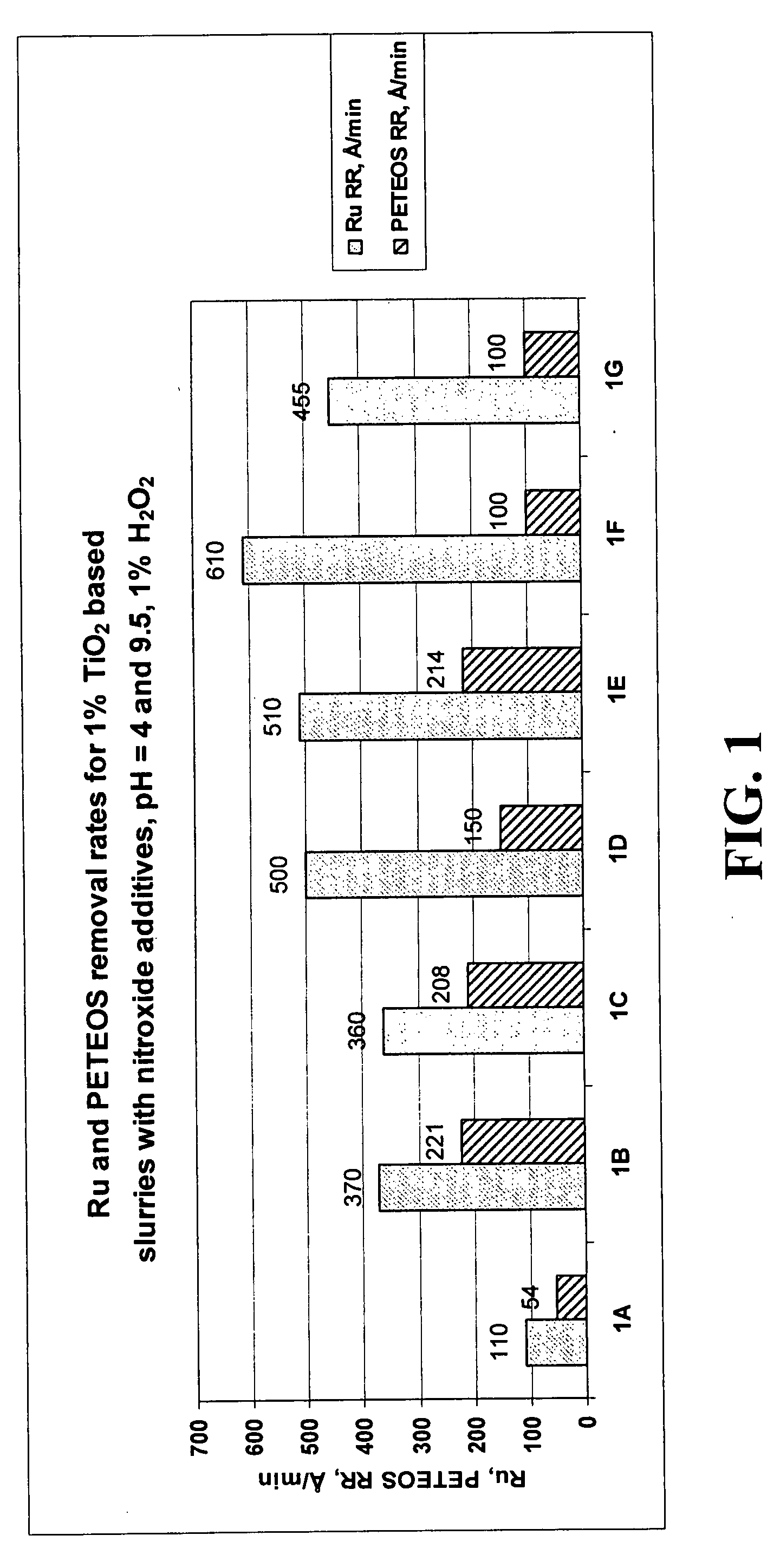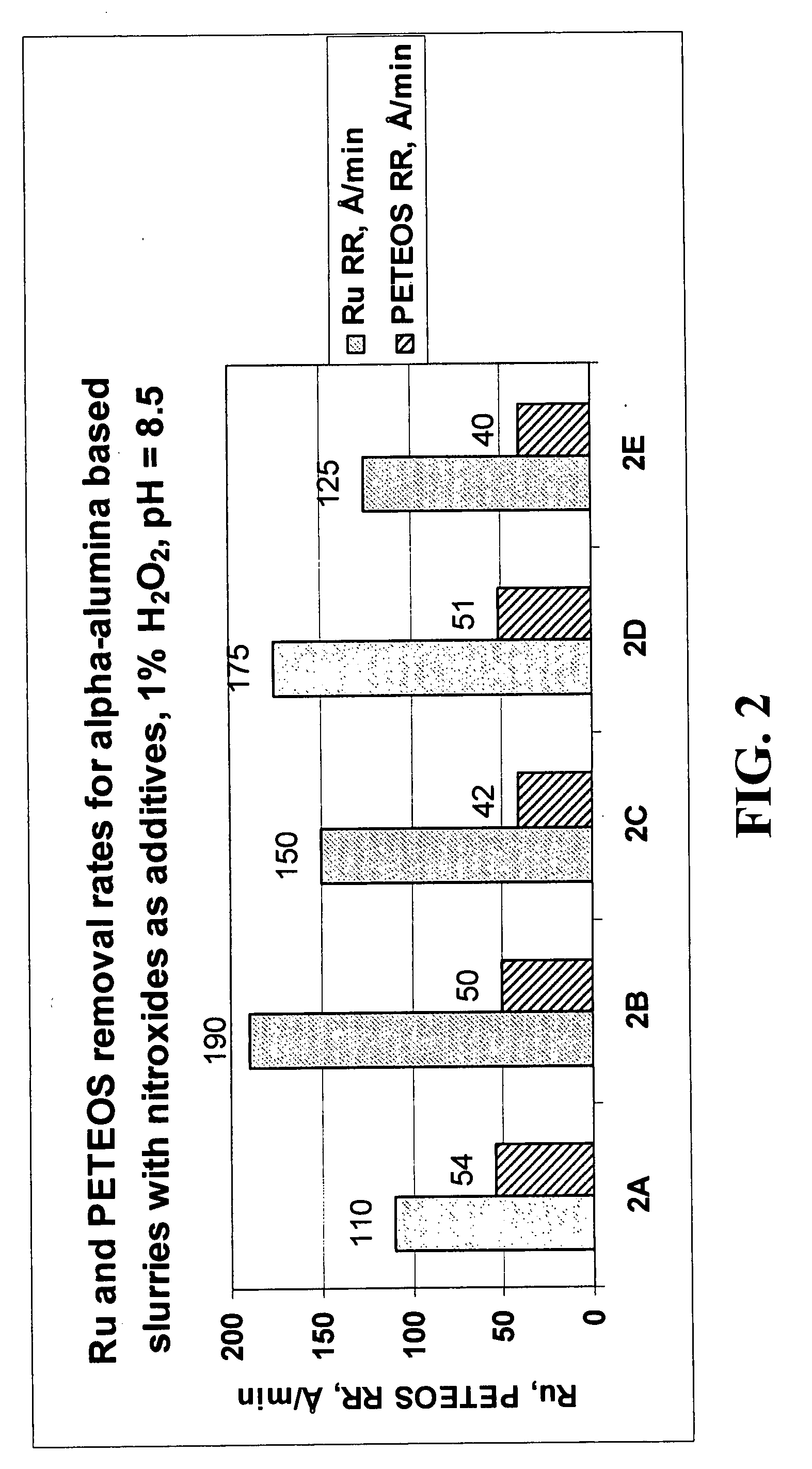Ruthenium CMP compositions and methods
a technology of compositions and ruthenium cmp, applied in lapping machines, other chemical processes, manufacturing tools, etc., can solve problems such as semiconductor fabrication, difficulty in designing effective polishing systems for semiconductor wafers, and various problems, and achieve the effect of high ruthenium removal rate and adequate ruthenium removal ra
- Summary
- Abstract
- Description
- Claims
- Application Information
AI Technical Summary
Benefits of technology
Problems solved by technology
Method used
Image
Examples
example 1
[0039]This example illustrates the use of compositions of the invention comprising a titania abrasive and 4-hydroxy-TEMPO (“4-HOT”) to polish ruthenium and PETEOS blanket wafers.
[0040]CMP compositions of the invention were prepared, which had the formulations shown in Table 1. The compositions were utilized to polish ruthenium and PETEOS blanket wafers (about 4-inch diameter) in the presence of about 1 percent by weight hydrogen peroxide, on a Logitech polisher having a D100 polishing pad, under the following polishing conditions: platen speed of about 93 revolutions-per-minute (rpm), carrier speed of about 90 rpm, down pressure of about 3.1 pounds-per-square inch (psi), and a slurry flow rate of about 180 milliliters-per-minute (mL / min). FIG. 1 provides a graph of the ruthenium and PETEOS removal rates observed for each composition, in comparison to control compositions comprising about 0.7 percent by weight alumina or about 1 percent by weight titania, and having no added N—O liga...
example 2
[0042]This example illustrates the use of compositions of the invention comprising an alumina abrasive and 4-hydroxy-TEMPO to polish ruthenium and PETEOS blanket wafers.
[0043]CMP compositions of the invention were prepared, each of which had a pH of about 8.5, and the formulations shown in Table 2. The compositions were utilized to polish ruthenium and PETEOS blanket wafers (about 4-inch diameter) in the presence of about 1 percent by weight hydrogen peroxide, on a Logitech polisher having a D100 polishing pad, under the following polishing conditions: platen speed of about 93 rpm, carrier speed of about 90 rpm, down pressure of about 3.1 psi, and a slurry flow rate of about 180 mL / min. FIG. 2 provides a graph of the ruthenium and PETEOS removal rates observed for each composition, in comparison to a control composition comprising about 0.7 percent by weight alumina having no added N—O ligand.
TABLE 2ExampleFormulation2A0.7 wt. % alumina (98 nm mean particle size)control2B0.7 wt. % a...
example 3
[0045]This example illustrates the use of compositions of the invention comprising silica and mixed silica / titania abrasives in combination with 4-hydroxy-TEMPO to polish ruthenium and PETEOS blanket wafers.
[0046]CMP compositions of the invention were prepared, which had the formulations shown in Table 3. Each composition had a pH of about 5. The compositions were utilized to polish ruthenium and PETEOS blanket wafers (about 4-inch diameter) in the presence of about 1 percent by weight hydrogen peroxide, on a Logitech polisher having a D100 polishing pad, under the following polishing conditions: platen speed of about 93 rpm, carrier speed of about 90 rpm, down pressure of about 3.1 psi, and a slurry flow rate of about 180 mL / min. FIG. 3 provides a graph of the ruthenium and PETEOS removal rates observed for each composition, in comparison to three control compositions having no added N—O ligand (i.e., 3A: about 0.7 percent by weight alumina (pH 8.5); 3B: about 6 percent by weight c...
PUM
| Property | Measurement | Unit |
|---|---|---|
| mean particle size | aaaaa | aaaaa |
| pH | aaaaa | aaaaa |
| pH | aaaaa | aaaaa |
Abstract
Description
Claims
Application Information
 Login to View More
Login to View More - R&D
- Intellectual Property
- Life Sciences
- Materials
- Tech Scout
- Unparalleled Data Quality
- Higher Quality Content
- 60% Fewer Hallucinations
Browse by: Latest US Patents, China's latest patents, Technical Efficacy Thesaurus, Application Domain, Technology Topic, Popular Technical Reports.
© 2025 PatSnap. All rights reserved.Legal|Privacy policy|Modern Slavery Act Transparency Statement|Sitemap|About US| Contact US: help@patsnap.com



